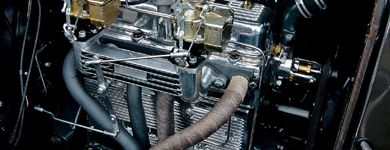
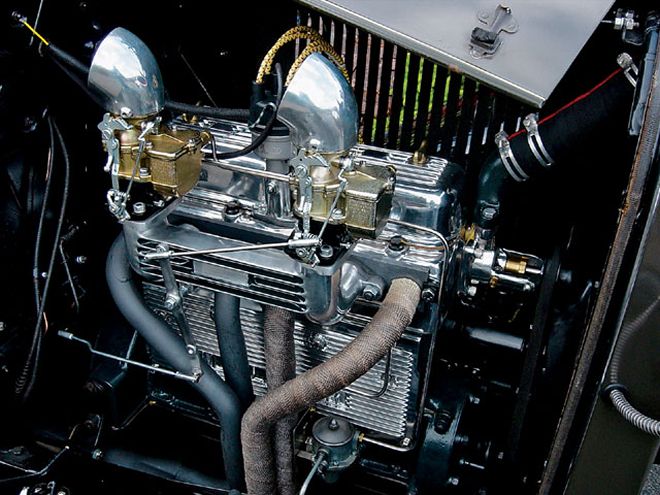 Four-banger speed equipment isn't getting older, it's getting better. Gerald Greenfield's '32 Ford Model B400 convertible sedan is equipped with a new Miller-Schofield-Cragar overhead valve (OHV) conversion from Steve Serr.
Four-banger speed equipment isn't getting older, it's getting better. Gerald Greenfield's '32 Ford Model B400 convertible sedan is equipped with a new Miller-Schofield-Cragar overhead valve (OHV) conversion from Steve Serr.
We've said it before, but it deserves repeating: Four-bangers formed the foundation hot rodding was built on. And while there is no denying today's engines are technologically superior in every way, vintage four-cylinders still have appeal, even though it's more emotionally so than practical. Contemporary engines do what they do with detached efficiency; you feel connected to the process of internal combustion with a vintage four-banger. They have a unique feel that appeals to the soul, an unmistakable sound-even the uninitiated won't think it's a small-block Chevy-and some aficionados say the little wisps of blow-by make 'bangers smell different than other engines.
While Model Ts still have a following, we're going to be dealing with Model A and B Fords for our purposes, and now is as good a time as any to dispense with the myth of the counterbalanced Model C-Ford never produced such an engine, but more on that shortly.
Ford produced the Model A from 1928-31; the engine displaced 200.5 ci, had 4.2:1 compression, and cranked out 40 hp. The crankshaft lacked counterweights and poured rod and main bearings were used, oil was delivered to the three-mains by gravity and to the rods by dippers on the caps, and the flywheel weighed a whopping 62 1/2 pounds.
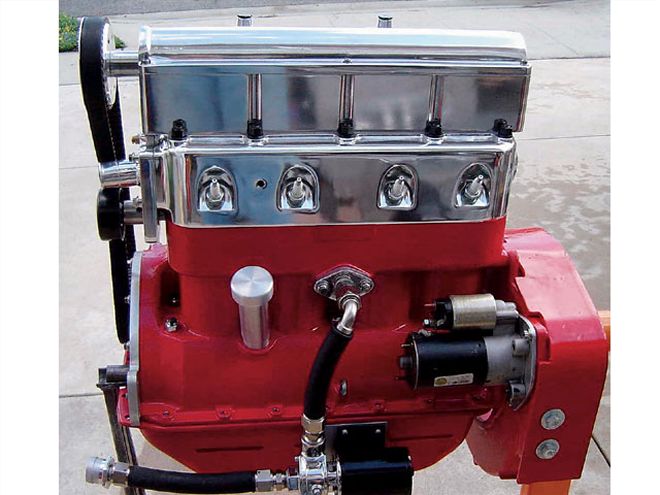 Is a high-tech 'banger a contradiction in terms? This is a Kruegel-Serr overhead cam conversion.
Is a high-tech 'banger a contradiction in terms? This is a Kruegel-Serr overhead cam conversion.
The Model B four-cylinder was introduced in 1932, and the four-cylinder engine had undergone a number of changes while the Model 18 V-8 was in the spotlight. The most obvious was a new fuel pump on the right side-an easy way to tell an A from a B is the presence of a fuel pump mount. The engine now had pressurized main and cam bearings, and, thanks to slightly higher compression and improved carburetion, horsepower was up to 50. A new counterbalanced crankshaft was introduced late in the production year.
By the time 1933 rolled around, Ford had the V-8 pretty well figured out; most of the earlier problems had been resolved and sales of four-cylinder cars dropped dramatically, although the engines were still being sold as replacements. Interestingly, Ford still referred to the four-cylinder engines in '33 and '34 as the Model B. These engines had a shorter three-bolt water pump housing and a 39-pound flywheel. The myth of the '33-34 C probably got started because all these engines did have counterbalanced crankshafts and the letter C cast into the head. The facts are the '32 head also had a C cast in, the counterbalanced crank appeared in late 1932, and Ford never made printed reference to a Model C.
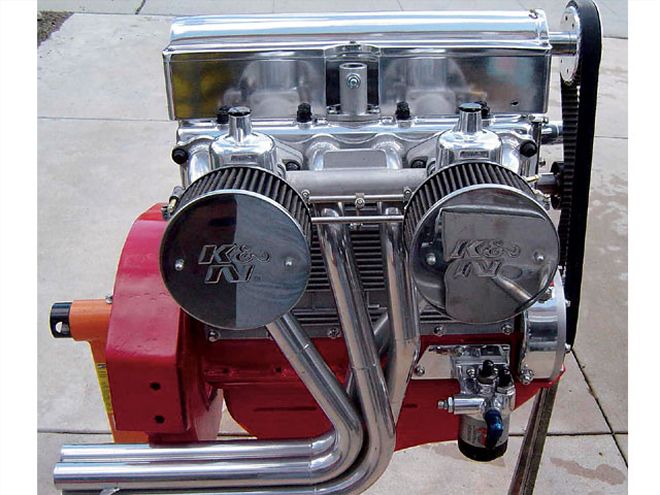 Dual side-draft carburetors and tube headers are part of the Kruegel-Serr OHC package.
Dual side-draft carburetors and tube headers are part of the Kruegel-Serr OHC package.
Building One Today
We talked to a number of people who deal with Model A restorers and found there's been a huge change in how that group views their cars. The folks at Arizona Model A, who sell Weber carburetor conversions and performance exhaust manifolds, among other parts, tell us engine modifications are much more common than they once were. Max Herman Jr. at H&H agrees and adds that even the engines he builds for restorations undergo a variety of modifications.
H&H Flatheads builds a surprising number of four-bangers each year, and even those destined for restorations receive insert rod and main bearings and billet aluminum timing gears, and are usually sleeved to standard bore size. Most of those modifications are aimed at reliability; for those who want to step performance up a notch, Max Jr. suggests an H&H touring grind cam, larger intake valves, and some minor porting. Typically, one of these engines makes around 65 hp and has a 3,500-rpm redline. For those who want another 10 or so horsepower, H&H suggests a "super-touring cam" along with taking 0.060-inch off the head for more compression. The redline is still 3,500 rpm, primarily due to an oiling system that still uses dippers on the rods.
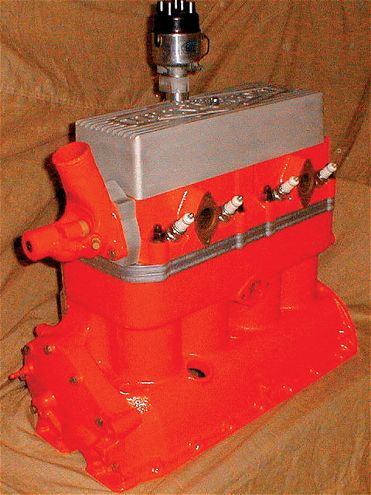 The Jern Thunderbolt is a unique conversion that adapts a '28 Chevy or Olds three-port head to a Model A or T.
The Jern Thunderbolt is a unique conversion that adapts a '28 Chevy or Olds three-port head to a Model A or T.
Max Jr. also has a list of modifications to suggest for the more performance-minded street rod applications. First off is full-pressure oiling; that in itself ups the redline to 5,000 rpm. Billet main caps strengthen the bottom end; Pro-Flo valves, a hotter cam, and an aftermarket head all help a 'banger breathe. Max Jr. suggests two 97 carburetors, tube headers, and Mallory ignition. A combination such as this is good for 100-plus horsepower and will cruise with traffic all day long.
Finally, H&H will add one of Steve Serr's Miller Hi-Speed heads for those who want to pull all the stops. With 150 reliable horsepower on tap, and a surprising amount of torque, as well, few will believe there's a vintage 'banger under the hood-including the driver.
Is A 'Banger For You?
Do some research if you're interested in hopped-up four-cylinder engines; a good place to start is a subscription to FAST, an organization dedicated to the subject. The fact is, four-bangers aren't for everyone. They're going to require some tinkering from time to time, and you've got to appreciate a certain amount of mechanical eccentricity. 'Bangers can be built to be reliable and keep up with traffic, especially in a light roadster or coupe, but they're not going to perform like a V-8, so you'll be disappointed if your expectations aren't realistic. And then there is the cost involved. If there were ever an example of the old adage, "Speed costs money, how fast do you want to go?" a four-banger is it. A near-stock engine is very affordable, and even a warmed-up Flathead touring engine isn't going to break the bank, but an OHV conversion is where the real horsepower is and that will up the ante 3 to 4 grand.
Does building a car around an engine that's almost 90 years old make any sense in the great scheme of things? If you say no, that's understandable, and there should probably be a crate motor in your future. But, if the idea brings even a slight grin to your face, you just may be 'banger material.